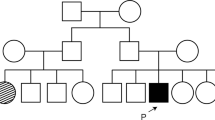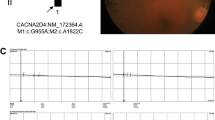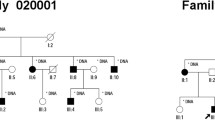Abstract
Retinitis pigmentosa (RP) is a clinically and genetically heterogeneous disorder characterized by night blindness, visual field constriction, and severely reduced visual acuity. Despite a number of genes being implicated in RP pathogenesis, the genetic etiology of the disease remains unknown in many patients. In this study, our aim was to identify the disease-causing mutation of a large Chinese family with autosomal dominant RP (adRP). Targeted exon capture sequencing was initially performed to screen mutations in known disease-causing genes, followed by exome sequencing. In doing so, a heterozygous mutation in ADIPOR1 (c.929A > G) that results in an amino acid substitution (p.Y310C) was identified to co-segregate with the disease phenotype in this family. Adipor1 is wildly expressed throughout the body, but appears to be enriched in the photoreceptor inner and outer segments. The p.Y310C mutation, predicted to affect the structure and function of the protein, was confirmed to affect protein folding and its subcellular localization in vitro. In addition, knockdown of adipor1 expression in a zebrafish model with morpholino (MO) preferentially reduced the number of rod photoreceptors, with no effect on the number of cones, a phenotype that is characteristic of RP. Furthermore, the knockdown phenotype was partially rescued by injecting wild-type, but not mutant, human ADIPOR1 mRNA. We conclude that ADIPOR1 is a novel adRP-causing gene and plays an important role in rod development and maintenance.






Similar content being viewed by others
References
Adzhubei I, Jordan DM, Sunyaev SR (2013) Predicting functional effect of human missense mutations using PolyPhen-2. Curr Protoc Hum Genet. doi:10.1002/0471142905.hg0720s76
Bazan NG (2006) Cell survival matters: docosahexaenoic acid signaling, neuroprotection and photoreceptors. Trends Neurosci 29:263–271
Bazan NG (2007) Homeostatic regulation of photoreceptor cell integrity: significance of the potent mediator neuroprotectin D1 biosynthesized from docosahexaenoic acid: the Proctor Lecture. Invest Ophthalmol Vis Sci 48:4866–4881
Bazan NG, Molina MF, Gordon WC (2011) Docosahexaenoic acid signalolipidomics in nutrition: significance in aging, neuroinflammation, macular degeneration, Alzheimer’s, and other neurodegenerative diseases. Annu Rev Nutr 31:321–351
Berg AH, Combs TP, Scherer PE (2002) ACRP30/adiponectin: an adipokine regulating glucose and lipid metabolism. Trends Endocrinol Metab 13:84–89
Chizzolini M, Galan A, Milan E, Sebastiani A, Costagliola C, Parmeggiani F (2011) Good epidemiologic practice in retinitis pigmentosa: from phenotyping to biobanking. Curr Genomics 12:260–266
Fu Q, Wang F, Wang H et al (2013) Nest-generation sequencing-based molecular diagnosis of a Chinese patient cohort with autosomal recessive retinitis pigmentosa. Invest Ophthalmol Vis Sci 54:4158–4166
Fu Z, Lofqvist CA, Shao Z et al (2015) Dietary ω-3 polyunsaturated fatty acids decrease retinal neovascularization by adipose-endoplasmic reticulum stress reduction to increase adiponectin. Am J Clin Nutr 101:879–888
Fu Z, Gong Y, Löfqvist C, Hellström A, Smith LE (2016) Review: adiponectin in retinopathy. Biochim Biophys Acta 1862:1392–1400
Higuchi A, Ohashi K, Kihara S, Walsh K, Ouchi N (2009) Adiponectin suppresses pathological microvessel formation in retina through modulation of tumor necrosis factor-alpha expression. Circ Res 104:1058–1065
Holland WL, Miller RA, Wang ZV et al (2011) Receptor-mediated activation of ceramidase activity initiates the pleiotropic actions of adiponectin. Nat Med 17:55–63
Hsieh MH, Goodman HM (2005) A novel gene family in Arabidopsis encoding putative heptahelical transmembrane proteins homologous to human adiponectin receptors and progestin receptors. J Exp Bot 56:3137–3147
Iwabu M, Yamauchi T, Okada-Iwabu M et al (2010) Adiponectin and AdipoR1 regulate PGC-1-alpha and mitochondria by Ca(2+) and AMPK/SIRT1. Nature 464:1313–1319
Kaarniranta K, Paananen J, Nevalainen T et al (2012) Adiponection receptor 1 gene (ADIPOR1) variant is associated with advanced age-related macular degeneration in Finnish population. Neurosci Lett 513:233–237
Kadowaki T, Yamauchi T (2005) Adiponectin and adiponectin receptors. Endocr Rev 26:439–451
Krumm N, Sudmant PH, Ko A et al (2012) Copy number variation detection and genotyping from exome sequence data. Genome Res 22:1525–1532
Li H, Durbin R (2009) Fast and accurate short read alignment with Burrows-Wheeler transform. Bioinformatics 25:1754–1760
Li H, Handsaker B, Wysoker A et al (2009) The sequence alignment/map format and SAMtools. Bioinformatics 25:2078–2079
Lin T, Qiu Y, Liu Y, Mohan R, Li Q, Lei B (2013) Expression of adiponectin and its receptors in type 1 diabetes mellitus in human and mouse retinas. Mol Vis 19:1769–1778
Lyzogubov VV, Tytarenko RG, Bora NS, Bora PS (2012) Inhibitory role of adiponectin peptide I on rat choroidal neovascularization. Biochim Biophys Acta 1823:1264–1272
Mao D, Peng H, Li Q et al (2012) Aqueous humor and plasma adiponectin levels in proliferative diabetic retinopathy patients. Curr Eye Res 37:803–808
Ng PC, Henikoff S (2003) SIFT: predicting amino acid changes that affect protein function. Nucleic Acids Res 31:3812–3814
Nishiguchi KM, Tearle RG, Liu YP et al (2013) Whole genome sequencing in patients with retinitis pigmentosa reveals pathogenic DNA structural changes and NEK2 as a new disease gene. Proc Natl Acad Sci USA 110:16139–16144
Nishio S, Gibert Y, Bernard L, Brunet F, Triqueneaux G, Laudet V (2008) Adiponectin and adiponectin receptor genes are coexpressed during zebrafish embryogenesis and regulated by food deprivation. Dev Dyn 237:1682–1690
Omae T, Nagaoka T, Yoshida A (2015) Relationship between retinal blood flow and serum Adiponectin concentrations in patients with Type 2 diabetes mellitus. Invest Ophthalmol Vis Sci 56:4143–4149
Rice DS, Calandria JM, Gordon WC et al (2015) Adiponectin receptor 1 conserves docosahexaenoic acid and promotes photoreceptor cellsurvival. Nat Commun 6:6228
Schwarz JM, Rödelsperger C, Schuelke M, Seelow D (2010) MutationTaster evaluates disease-causing potential of sequence alterations. Nat Methods 7:575–576
Tanabe H, Fujii Y, Okada-Iwabu M et al (2015) Crystal structures of the human adiponectin receptors. Nature 520:312–316
Tang YT, Hu T, Arterburn M, Boyle B, Bright JM, Emtage PC, Funk WD (2005) PAQR proteins: a novel membrane receptor family defined by an ancient 7-transmembrane pass motif. J Mol Evol 61:372–380
Wang F, Li H, Xu M et al (2014) A homozygous missense mutation in NEUROD1 is associated with nonsyndromic autosomal recessive retinitispigmentosa. Invest Ophthalmol Vis Sci 56:150–155
Worth CL, Preissner R, Blundell TL (2011) SDM–a server for predicting effects of mutations on protein stability and malfunction. Nucleic Acids Res 39:W215–W222
Wright AF, Chakarova CF, Abd El-Aziz MM, Bhattacharya SS (2010) Photoreceptor degeneration: genetic and mechanistic dissection of a complex trait. Nat Rev Genet 11:273–284
Xu L, Hu L, Ma K, Li J, Jonas JB (2006) Prevalence of retinitis pigmentosa in urban and rural adult Chinese: the Beijing Eye Study. Eur J Ophthalmol 16:865–866
Xu M, Eblimit A, Wang J et al (2016) ADIPOR1 is mutated in syndromic retinitis pigmentosa. Hum Mutat 37:246–249
Yamauchi T, Kadowaki T (2013) Adiponectin receptor as a key player in healthy longevity and obesity-related diseases. Cell Metab 17:185–196
Yamauchi T, Nio Y, Maki T et al (2007) Targeted disruption of AdipoR1 and AdipoR2 causes abrogation of adiponectin binding and metabolic actions. Nat Med 13:332–339
Yang L, Cui H, Yin X et al (2015) Dependable and efficient clinical molecular diagnosis of Chinese RP patient with targeted Exon sequencing. PLoS One 10:e0140684
Zhao L, Wang F, Wang H et al (2015) Next-generation sequencing-based molecular diagnosis of 82 retinitis pigmentosa probands from Northern Ireland. Hum Genet 134:217–230
Acknowledgments
The authors thank the patients and their family members for their participation in this study. This study was supported by the National Natural Science Foundation of China (http://www.nsfc.gov.cn/ Grant Numbers: 81170877, 81470666 LY and 81371264 BZ); the clinical Key Project of Peking University Third Hospital (BYSY2014004 LY); the Seeding Grant for Medicine and Life Sciences of Peking University (2014-MB-20 LY); 973 program (2015CB942803), a Peking University grant for translational research (ZM and BZ).
Author information
Authors and Affiliations
Corresponding authors
Ethics declarations
Conflict of interest
The authors declare that they have no conflict of interest.
Research involving human participants
All procedures performed in studies involving human participants were in accordance with the ethical standards of the Peking University Third Hospital Medical Ethics Committee (No. 2012093) and with the 1964 Helsinki declaration and its later amendments or comparable ethical standards.
Informed consent
Informed consent was obtained from all individual participants or guardians on behalf of all of the minors/children participants included in the study.
Research involving animals
All applicable international, national, and/or institutional guidelines for the care and use of animals were followed.
Additional information
J. Zhang, C. Wang, and Y. Shen are co-first authors.
Electronic supplementary material
Below is the link to the electronic supplementary material.
Fig. S1
Screenshot of the SDM analysis results for the Y310C mutation in ADIPOR1. On the left, information about the wildtype and mutant residue is displayed as well as the predicted effect on protein stability. In the middle, the structural context of the wildtype and mutant amino acids are shown in the Jmol applet with the residues colored blue (Y) and yellow (C), respectively (TIFF 7478 kb)
Rights and permissions
About this article
Cite this article
Zhang, J., Wang, C., Shen, Y. et al. A mutation in ADIPOR1 causes nonsyndromic autosomal dominant retinitis pigmentosa. Hum Genet 135, 1375–1387 (2016). https://doi.org/10.1007/s00439-016-1730-2
Received:
Accepted:
Published:
Issue Date:
DOI: https://doi.org/10.1007/s00439-016-1730-2




